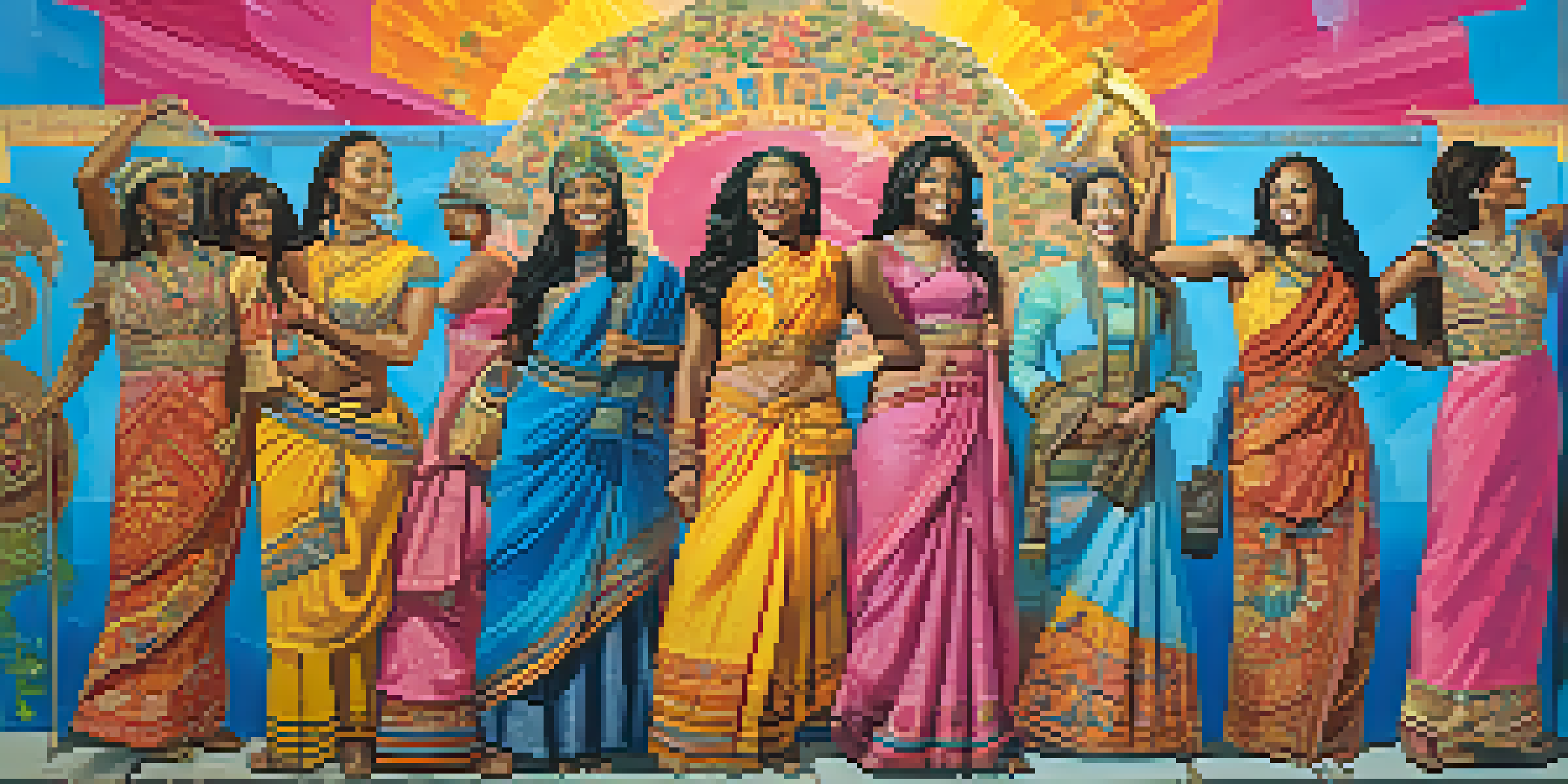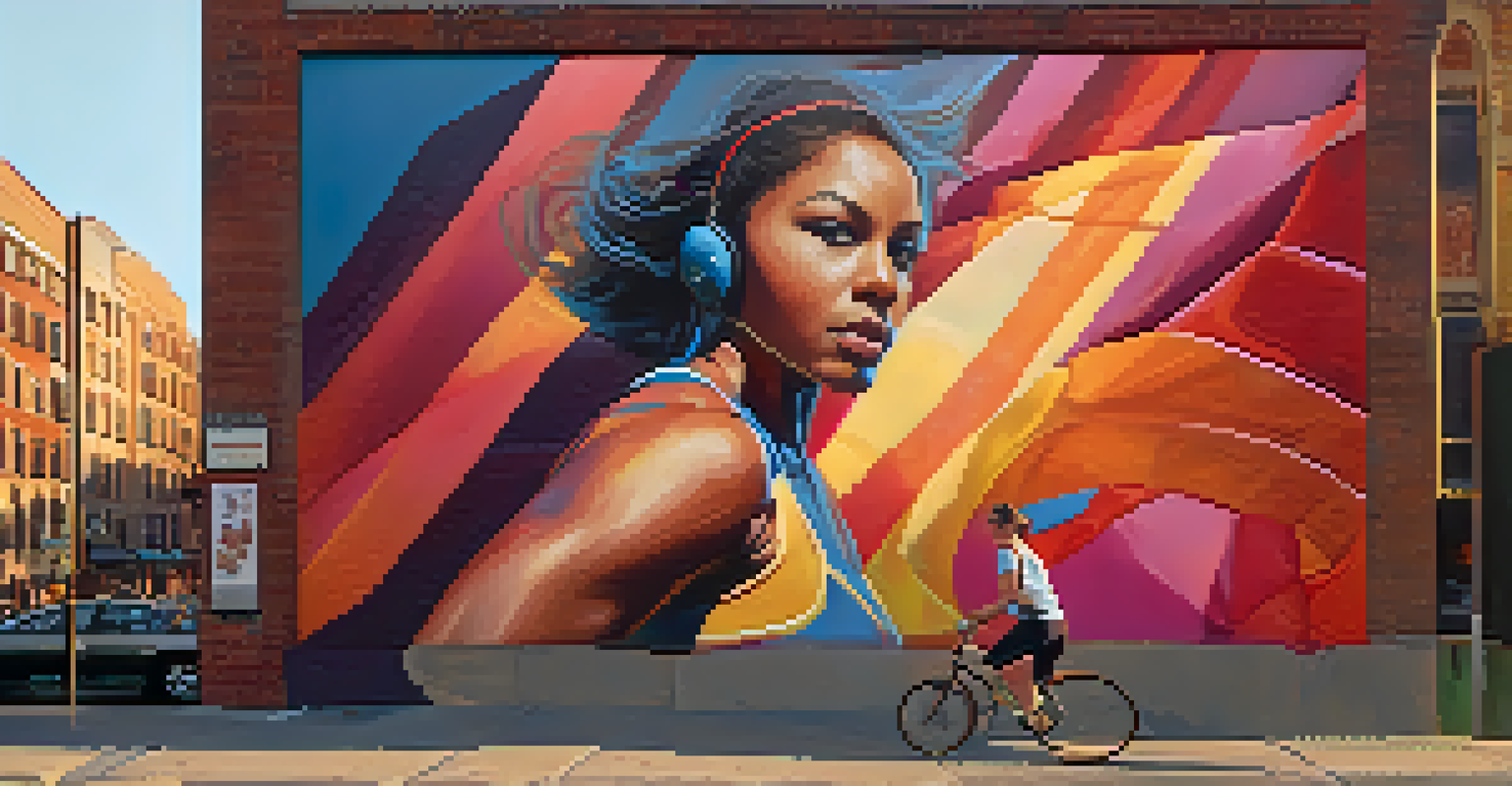The Politics of Gender in Public Art Installations

Understanding Gender Politics in Art
Gender politics in art examines how societal views on gender influence artistic expression. These dynamics can be seen vividly in public art installations, where the chosen themes often reflect broader societal conversations. Artists use their work to challenge norms and provoke thought, making the viewer confront their own perspectives on gender.
Art is a way of expressing and challenging the realities of gender in society.
Public art serves as a canvas for discussing gender inequality, representation, and identity. For instance, a mural highlighting women's achievements can inspire pride and awareness in the community. Through these installations, artists invite the public to engage in a dialogue about gender roles and expectations.
Moreover, the choice of materials and placement of artwork can also convey messages about gender. These elements can either reinforce traditional stereotypes or subvert them, depending on the artist's intent. By understanding these nuances, we can appreciate how public art acts as a mirror reflecting society's evolving attitudes toward gender.
Historical Context of Gender in Public Art
Historically, public art has often been dominated by male perspectives, which has influenced the themes and subjects depicted. For many years, women's contributions to art were sidelined, and their stories were rarely told in public spaces. This lack of representation has led to a growing movement to reclaim public art as a platform for diverse gender narratives.

In recent decades, female artists have increasingly taken center stage, using public installations to assert their voices. For example, the rise of feminist art in the 1970s paved the way for more women to explore public art as a medium for expression. This shift has allowed for a broader range of experiences and stories to be shared with the public.
Public Art Reflects Gender Issues
Public art installations serve as a powerful medium for addressing and reflecting societal conversations around gender politics.
Additionally, the historical absence of gender diversity in public art has prompted calls for change. Communities are now advocating for installations that celebrate all genders, pushing back against the long-standing male-centric narrative. This evolution in public art reflects a society that is beginning to recognize and celebrate diverse gender identities.
Case Studies of Gender-Focused Installations
Several public art installations around the world focus explicitly on gender issues, providing insight into this dynamic interplay. One notable example is 'The Fearless Girl' statue, which stands defiantly in front of Wall Street's Charging Bull. This installation symbolizes female empowerment and challenges the traditional male-dominated financial industry.
The role of art is not a mirror to reflect reality, but a hammer with which to shape it.
Another compelling case is the 'Luchadoras' project, featuring portraits of female wrestlers in Mexico. This art celebrates strong women who break societal norms and challenge gender expectations. By placing these installations in public spaces, artists create opportunities for viewers to engage with and reflect on gender roles in society.
These case studies illustrate how public art not only represents women and gender diversity but also encourages dialogue about their roles in our communities. Each installation serves as a catalyst for discussion, prompting viewers to consider how gender influences their lives. Through such projects, public art becomes a powerful tool for advocacy and change.
The Role of Intersectionality in Gender Art
Intersectionality acknowledges that individuals experience multiple identities and social categories simultaneously, including race, class, and gender. In the context of public art, this means recognizing that gender cannot be viewed in isolation from other factors that shape individual experiences. Artists increasingly incorporate intersectionality into their work, creating pieces that resonate with diverse audiences.
For instance, installations that highlight the experiences of women of color demonstrate how gender and race intersect in unique ways. These artworks challenge the notion of a singular female experience, instead showcasing the richness of multiple identities. By embracing intersectionality, public art can foster inclusivity and understanding.
Intersectionality Enriches Narratives
Incorporating intersectionality into public art allows for a deeper exploration of how various identities, such as race and class, intersect with gender.
Furthermore, intersectional art encourages collaboration among artists from different backgrounds, leading to richer narratives and perspectives. This collective approach strengthens the impact of public art installations, making them more relatable and powerful. As a result, intersectionality plays a crucial role in shaping the future of public art and its representation of gender.
Public Response and Community Engagement
Community engagement is essential for the success of public art installations focused on gender. When artworks resonate with local audiences, they can spark conversations and inspire change. This connection between the artwork and the community is vital for fostering a sense of belonging and empowerment.
Public response to gender-themed art can vary, highlighting the complexity of societal views on gender issues. Some installations may receive overwhelming support, while others provoke criticism or controversy. This diverse range of reactions reflects the ongoing struggle for gender equality and the different perspectives people hold.
Involving the community in the creation process can lead to more meaningful installations. Artists who collaborate with local residents often produce work that speaks directly to their experiences and concerns. This approach not only enhances the artwork's relevance but also cultivates a shared sense of ownership and pride in public art.
Challenges Facing Gender Representation in Art
Despite progress, gender representation in public art still faces significant challenges. Many artists encounter barriers such as funding disparities, lack of visibility, and institutional biases. These obstacles can hinder the creation and display of works that address gender issues, limiting the diversity of voices in public spaces.
Moreover, societal attitudes toward gender continue to evolve, creating a moving target for artists. As conversations around gender identity and expression become more nuanced, artists must adapt their work to reflect these changes. This requires a delicate balance between staying relevant and honoring the core messages they wish to convey.
Community Engagement is Key
Active involvement of local communities in the creation of public art enhances its relevance and fosters a sense of ownership and empowerment.
Additionally, there is a risk of commercializing gender issues in art, where installations may prioritize aesthetic appeal over meaningful engagement. This trend can dilute the impact of gender-focused art, reducing it to mere decoration rather than a catalyst for change. Addressing these challenges is crucial for ensuring that public art remains a powerful platform for exploring gender politics.
The Future of Gender in Public Art
As society continues to grapple with complex gender dynamics, the future of public art holds promise for more inclusive and diverse representations. Emerging artists are increasingly prioritizing gender issues in their work, using innovative methods to engage with audiences. This shift signals a growing recognition of the importance of diverse voices in shaping public narratives.
Technological advancements also play a role in the evolution of public art. Digital media, augmented reality, and interactive installations offer new ways to explore gender topics, pushing the boundaries of traditional art forms. These developments can enhance viewer engagement, fostering a deeper understanding of gender issues.

Ultimately, the future of gender in public art depends on continued advocacy for representation and inclusivity. By supporting artists who address gender politics and encouraging community participation, we can create public art that reflects the rich tapestry of experiences within society. This ongoing dialogue will ensure that public art remains a vibrant space for challenging and redefining gender roles.